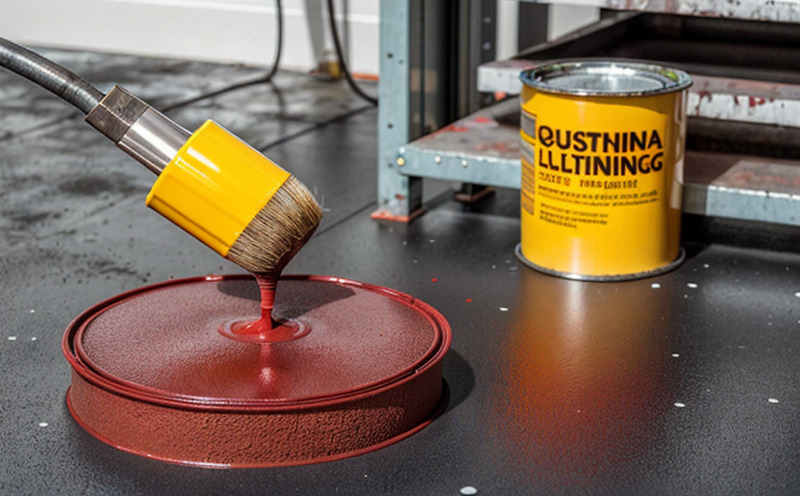DIN 53230 Elasticity Testing of Paint Films
The DIN 53230 standard is specifically designed to evaluate the elasticity and flexibility of paint films. This test method is crucial in industrial manufacturing, particularly for quality assurance and compliance purposes. The primary focus of this testing is to ensure that paint films can withstand mechanical stresses without cracking or losing their integrity.
Paints used in industrial applications often undergo significant physical stress due to environmental factors such as temperature changes, humidity levels, and mechanical impacts. Therefore, the elasticity of these coatings plays a critical role in determining their durability and performance over time. By conducting DIN 53230 tests, manufacturers can verify that their products meet or exceed industry standards for flexibility and resilience.
The test process involves applying specified loads to small samples cut from larger paint films. These samples are then subjected to stretching until they reach a predetermined elongation point. Afterward, the samples are held at this stretched position for a set period before being released. The recovery of the sample after removal of load is measured and compared against initial dimensions.
This type of testing helps identify potential weaknesses in coating formulations early in development stages or during production processes. It allows manufacturers to make informed decisions about improving formulation properties such as viscosity, pigment loading, additive content, etc., which directly impact a paint’s ability to retain its physical characteristics under various conditions.
For those involved in quality management and compliance, understanding the importance of elasticity testing ensures that products meet customer expectations regarding performance and longevity. For R&D engineers working on new coating technologies, this standard provides valuable insights into how different ingredients interact within formulations to influence final product behavior.
The DIN 53230 test also supports procurement activities by offering a standardized method for assessing suppliers’ compliance with contractually agreed upon specifications. Compliance officers responsible for ensuring adherence to regulatory requirements will find this testing protocol particularly useful when verifying that purchased materials comply with relevant international standards like ISO, ASTM, EN, IEC, etc.
Understanding the principles behind DIN 53230 elasticity testing can help stakeholders make better decisions regarding product design, material selection, and process optimization. This knowledge contributes significantly towards enhancing overall product quality and reliability in industrial manufacturing environments.
- Evaluates paint films' ability to maintain structural integrity under stress
- Identifies potential weaknesses early in the development cycle
- Supports decision-making processes related to formulation improvements
- Aids in verifying compliance with contractual agreements and regulatory standards
Applied Standards
DIN 53230:1987 specifies the procedure for determining the elasticity of paint films. This standard outlines specific requirements regarding sample preparation, test equipment, environmental conditions, and measurement techniques used during testing.
- Sample Preparation: Small rectangular specimens measuring approximately 40 mm x 25 mm are cut from larger paint films. Specimens should be free from defects or imperfections that could affect results.
- Test Equipment: A tensile testing machine capable of applying controlled loads to the samples is required. The equipment must have a suitable range and resolution for accurate measurements throughout the test sequence.
- Environmental Conditions: Tests should be conducted at room temperature (23 ± 2°C) with relative humidity between 50% and 60%. Samples need sufficient time to acclimate to these conditions before testing begins.
- Measurement Techniques: Specimens are stretched slowly until they reach a specified elongation value. The stretch rate is typically set at 1 mm/min. After reaching the desired elongation, samples remain in this position for one minute before being released instantaneously. Recovery measurements are taken immediately after release.
The DIN 53230 standard provides clear guidelines on how to perform these tests consistently across different labs and facilities. Compliance with these specifications ensures accurate comparisons between results obtained by various parties involved in the manufacturing process.
Customer Impact and Satisfaction
Implementing DIN 53230 elasticity testing contributes positively to customer satisfaction by ensuring consistent quality and reliability of industrial coatings. Here are some ways this impacts customers:
- Better Product Performance: By identifying potential issues early in the development process, manufacturers can refine their products to deliver superior performance.
- Enhanced Reputation: Consistent compliance with international standards enhances a company’s reputation among its customer base. This builds trust and loyalty.
- Increased Efficiency: Early detection of defects through rigorous testing leads to fewer rejections during quality assurance stages, resulting in increased efficiency throughout the supply chain.
- Better Decision Making: Accurate data provided by DIN 53230 tests enables informed decisions about formulation changes and process improvements. This translates into more efficient operations and reduced costs associated with subpar products.
In summary, implementing DIN 53230 elasticity testing not only meets regulatory requirements but also enhances customer satisfaction through superior product performance, reputation building, increased efficiency, and better decision-making capabilities.
Environmental and Sustainability Contributions
DIN 53230 elasticity testing plays a significant role in promoting sustainability within the industrial coatings industry. By ensuring that paints meet stringent flexibility criteria, this testing contributes to longer-lasting products with reduced environmental impact.
- Minimized Waste: Flexible coatings last longer on surfaces, reducing the frequency of reapplication needed over time. This translates into less waste generated during maintenance activities.
- Energy Efficiency: Longer-lasting coatings require fewer touch-ups and recoatings, leading to lower energy consumption associated with production processes.
- Sustainable Materials Usage: The ability to accurately assess paint film elasticity helps manufacturers optimize material usage, potentially reducing the overall carbon footprint of their operations.
- Better Resource Management: Improved product performance due to better elasticity means resources are used more effectively, contributing positively to resource management efforts.
In conclusion, incorporating DIN 53230 elasticity testing into industrial manufacturing processes supports sustainability goals by promoting longer-lasting products and efficient use of resources.





